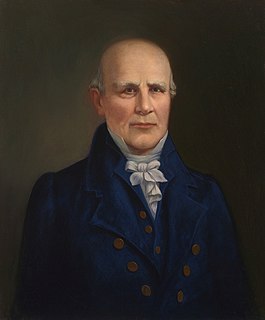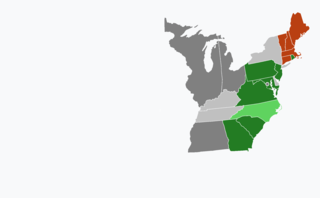Related Research Articles

The 7th United States Congress was a meeting of the legislative branch of the United States federal government, consisting of the United States Senate and the United States House of Representatives. It met in Washington, D.C. from March 4, 1801, to March 4, 1803, during the first two years of Thomas Jefferson's presidency. The apportionment of seats in the House of Representatives was based on the First Census of the United States in 1790. Both chambers had a Democratic-Republican majority, except during the Special session of the Senate, when there was a Federalist majority in the Senate.

Elections to the United States House of Representatives for the 15th Congress were held at various dates in different states between April 1816 and August 1817.

Elections to the United States House of Representatives for the 12th Congress were held at various dates in different states between April 1810 and August 1811 during President James Madison's first term.

Elections to the United States House of Representatives for the 8th Congress were held at various dates in each state, from April 26, 1802 to December 14, 1803 during Thomas Jefferson's first term in office. It was common in the early years of the United Congress for some states to elect representatives to a Congress after it had already convened. In the case of the 8th Congress, the representatives from New Jersey were only elected after its first meeting on October 17, 1803.

Maryland's 4th congressional district comprises portions of Prince George's County and Anne Arundel County. The seat is represented by Anthony G. Brown, a Democrat.
The United States Senate elections of 1802 and 1803 were elections for the United States Senate which had the Democratic-Republican Party assume an overwhelming control thereof.
The United States Senate elections of 1800 and 1801 were elections for the United States Senate that, coinciding with their takeover of the White House, led to the Democratic-Republican Party taking control of the United States Senate. Although the Federalists began the next (7th) Congress with a slim majority, they lost their majority shortly thereafter due to mid-year special elections.

The 1802 United States House of Representatives elections in New York were held from April 27 to 29, 1802, to elect 17 U.S. Representatives to represent the State of New York in the United States House of Representatives of the 8th United States Congress.

The 1804 United States House of Representatives elections in New York were held from April 24 to 26, 1804, to elect 17 U.S. Representatives to represent the State of New York in the United States House of Representatives of the 9th United States Congress. At the same time, a vacancy was filled in the 8th United States Congress.

The 1808 United States House of Representatives elections in New York were held from April 26 to 28, 1808, to elect 17 U.S. Representatives to represent the State of New York in the United States House of Representatives of the 11th United States Congress. At the same time, a vacancy was filled in the 10th United States Congress.

The 1816 United States House of Representatives elections in New York were held from April 23 to 25, 1816, to elect 27 U.S. Representatives to represent the State of New York in the United States House of Representatives of the 15th United States Congress. At the same time, a vacancy was filled in the 14th United States Congress.

Maryland gained 1 seat in reapportionment after the 1800 census. Rather than increasing the number of districts, however, Maryland made the Maryland 5 a plural district with 2 seats.
A special election was held in Massachusetts's 4th congressional district August 24, 1801 to fill a vacancy caused by the resignation of Levi Lincoln Sr. (DR) on March 5, 1801, before the first session of Congress, upon being appointed U.S. Attorney General.
A special election was held in Massachusetts's 12th congressional district on five occasions between September 25, 1801 and July 29, 1802 to fill a vacancy left by the resignation of Silas Lee (F) on August 20, 1801, prior to the beginning of the 1st Session of the 7th Congress.

The 2020 United States House of Representatives elections in Maryland was held on November 3, 2020, to elect the eight U.S. Representatives from the state of Maryland, one from each of the state's eight congressional districts. The elections coincided with the 2020 U.S. presidential election, as well as other elections to the House of Representatives, elections to the United States Senate and various state and local elections. On March 17, 2020, Governor Larry Hogan announced that the primary election would be postponed from April 28 to June 2 due to coronavirus concerns. On March 26, the Maryland Board of Elections met to consider whether in-person voting should be used for June's primary, and recommended that voting in June be mail-in only.
Hasan "Jay" Jalisi is an American politician who is a Democratic member of the Maryland House of Delegates. Dr. Jalisi is graduate of Johns Hopkins University. He is a medical doctor and has co-authored numbers medical research papers and two medical textbooks. He was first elected to the House of Delegates in 2015. Later that year Jalisi had his committee assignments changed after a judge issued a protective order against him. In March 2019 Jalisi was disciplined by the House Ethics Committee for the poor treatment of his staff.

A special election was held on April 28, 2020, after a February 4, 2020 primary, to fill the remainder of the term in the United States House of Representatives for Maryland's 7th congressional district in the 116th U.S. Congress. Elijah Cummings, the incumbent representative, died in office on October 17, 2019.

United States gubernatorial elections were held in 1802, in 12 states, concurrent with the House and Senate elections.